Semester 1 AMOM632 Project: Chocolate Business in New Zealand Analysis
VerifiedAdded on 2023/04/11
|5
|903
|226
Project
AI Summary
This project analyzes the chocolate business landscape in New Zealand, specifically focusing on NZOFL and its competitive positioning against major players like Green & Black's. The assignment proposes a combined retail chain and e-commerce distribution strategy as a key competitive advantage. It then delves into methods to improve multifactor productivity, highlighting the importance of technological advancements and the adoption of lean management principles. The assignment also explores the concept of takt time, providing calculations and examples relevant to the chocolate manufacturing process. The analysis includes references to relevant academic literature and provides a comprehensive overview of the operational and strategic considerations for a chocolate business in the New Zealand market. This assignment is a project from the Te Hoe Pakihi Department of Business, Ara Institute of Canterbury, and covers concepts from the AMOM632 Operations Management module.
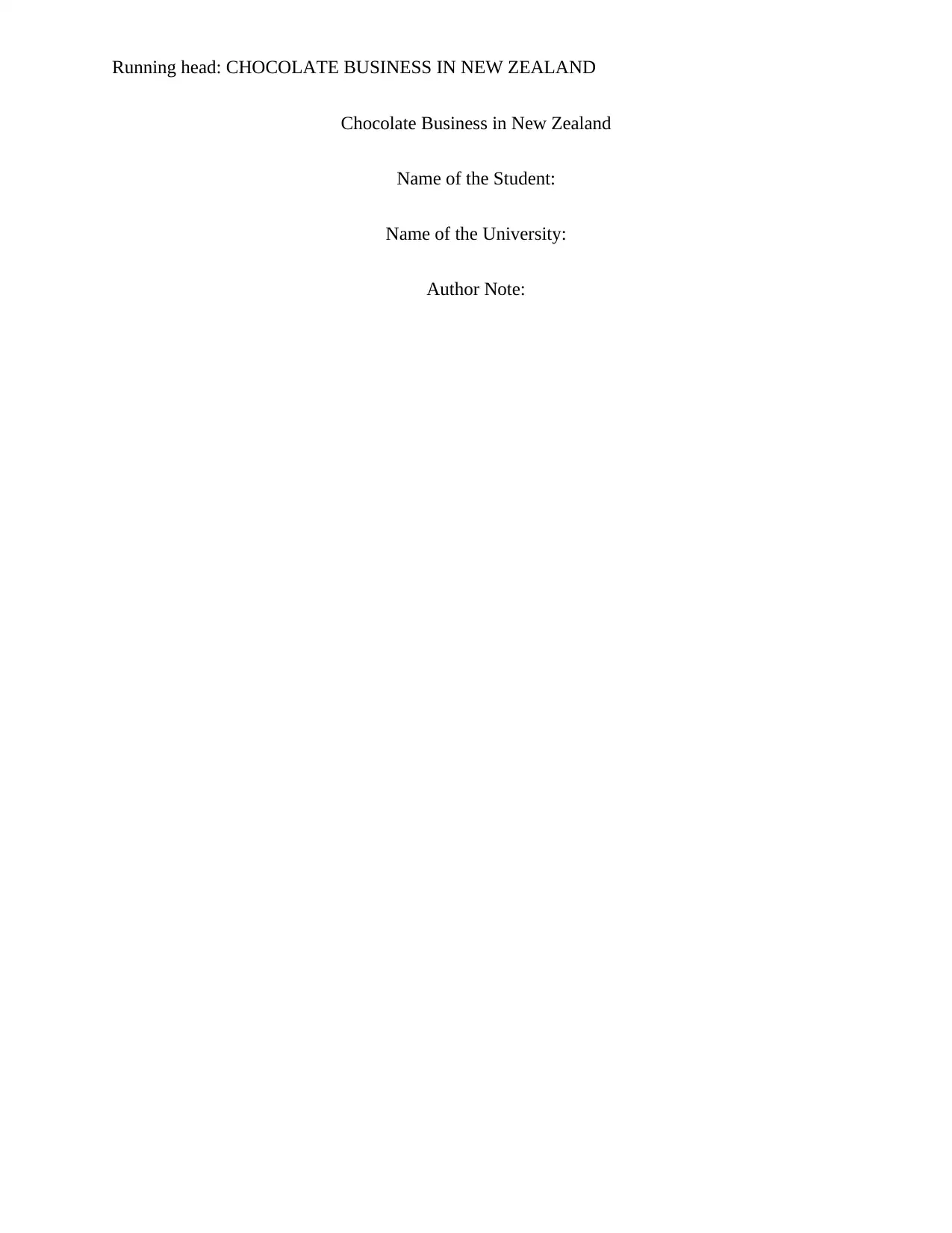
Running head: CHOCOLATE BUSINESS IN NEW ZEALAND
Chocolate Business in New Zealand
Name of the Student:
Name of the University:
Author Note:
Chocolate Business in New Zealand
Name of the Student:
Name of the University:
Author Note:
Paraphrase This Document
Need a fresh take? Get an instant paraphrase of this document with our AI Paraphraser
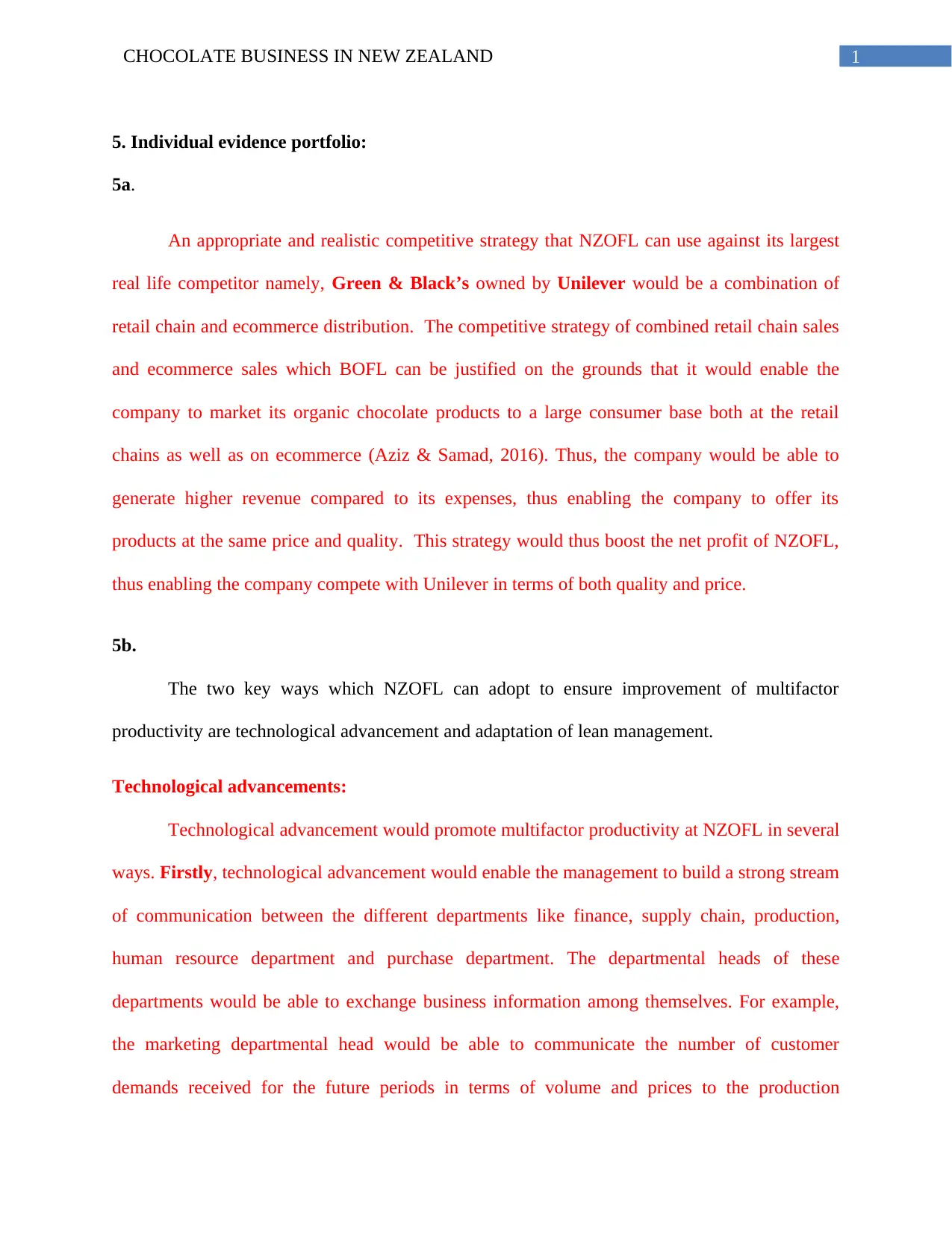
1CHOCOLATE BUSINESS IN NEW ZEALAND
5. Individual evidence portfolio:
5a.
An appropriate and realistic competitive strategy that NZOFL can use against its largest
real life competitor namely, Green & Black’s owned by Unilever would be a combination of
retail chain and ecommerce distribution. The competitive strategy of combined retail chain sales
and ecommerce sales which BOFL can be justified on the grounds that it would enable the
company to market its organic chocolate products to a large consumer base both at the retail
chains as well as on ecommerce (Aziz & Samad, 2016). Thus, the company would be able to
generate higher revenue compared to its expenses, thus enabling the company to offer its
products at the same price and quality. This strategy would thus boost the net profit of NZOFL,
thus enabling the company compete with Unilever in terms of both quality and price.
5b.
The two key ways which NZOFL can adopt to ensure improvement of multifactor
productivity are technological advancement and adaptation of lean management.
Technological advancements:
Technological advancement would promote multifactor productivity at NZOFL in several
ways. Firstly, technological advancement would enable the management to build a strong stream
of communication between the different departments like finance, supply chain, production,
human resource department and purchase department. The departmental heads of these
departments would be able to exchange business information among themselves. For example,
the marketing departmental head would be able to communicate the number of customer
demands received for the future periods in terms of volume and prices to the production
5. Individual evidence portfolio:
5a.
An appropriate and realistic competitive strategy that NZOFL can use against its largest
real life competitor namely, Green & Black’s owned by Unilever would be a combination of
retail chain and ecommerce distribution. The competitive strategy of combined retail chain sales
and ecommerce sales which BOFL can be justified on the grounds that it would enable the
company to market its organic chocolate products to a large consumer base both at the retail
chains as well as on ecommerce (Aziz & Samad, 2016). Thus, the company would be able to
generate higher revenue compared to its expenses, thus enabling the company to offer its
products at the same price and quality. This strategy would thus boost the net profit of NZOFL,
thus enabling the company compete with Unilever in terms of both quality and price.
5b.
The two key ways which NZOFL can adopt to ensure improvement of multifactor
productivity are technological advancement and adaptation of lean management.
Technological advancements:
Technological advancement would promote multifactor productivity at NZOFL in several
ways. Firstly, technological advancement would enable the management to build a strong stream
of communication between the different departments like finance, supply chain, production,
human resource department and purchase department. The departmental heads of these
departments would be able to exchange business information among themselves. For example,
the marketing departmental head would be able to communicate the number of customer
demands received for the future periods in terms of volume and prices to the production
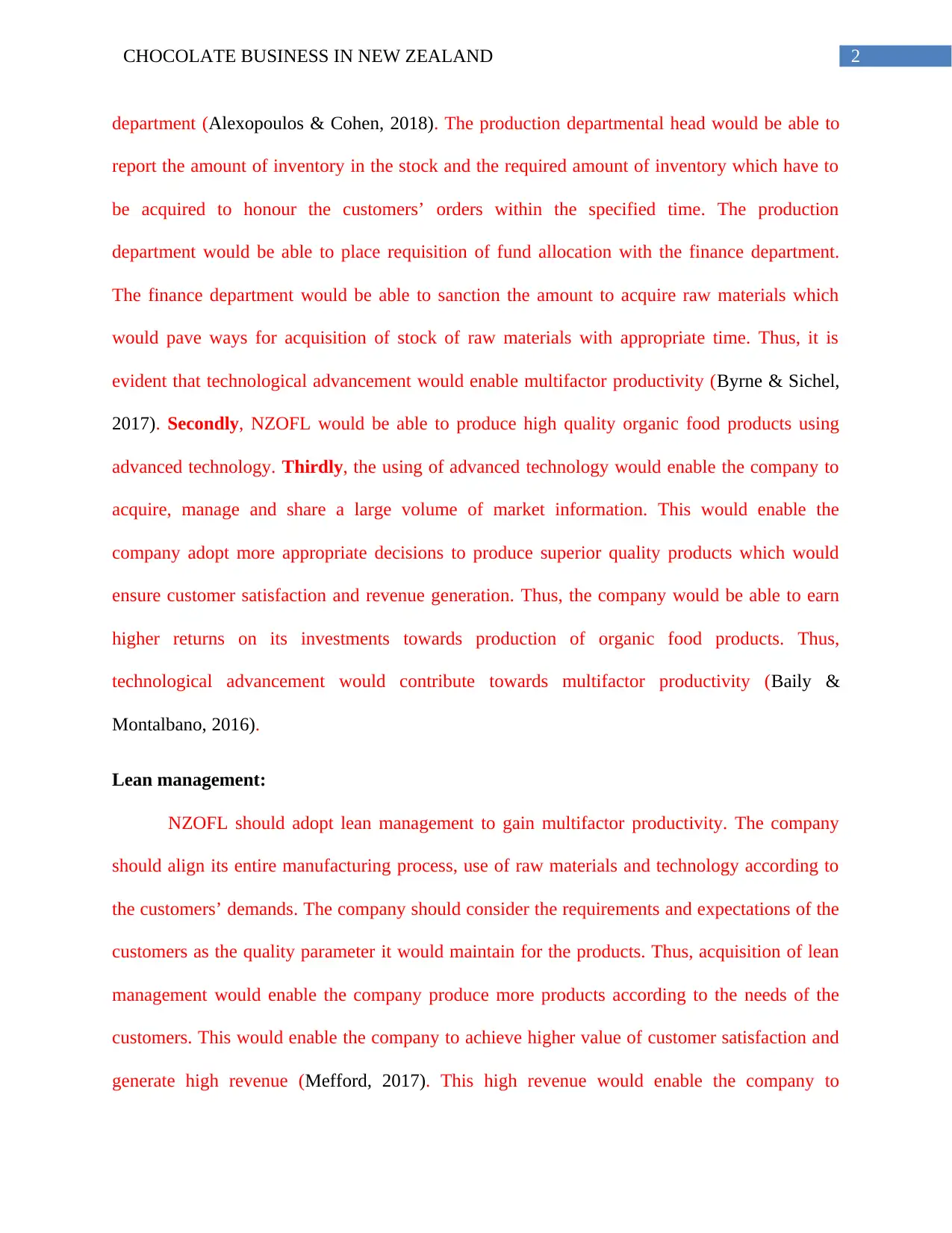
2CHOCOLATE BUSINESS IN NEW ZEALAND
department (Alexopoulos & Cohen, 2018). The production departmental head would be able to
report the amount of inventory in the stock and the required amount of inventory which have to
be acquired to honour the customers’ orders within the specified time. The production
department would be able to place requisition of fund allocation with the finance department.
The finance department would be able to sanction the amount to acquire raw materials which
would pave ways for acquisition of stock of raw materials with appropriate time. Thus, it is
evident that technological advancement would enable multifactor productivity (Byrne & Sichel,
2017). Secondly, NZOFL would be able to produce high quality organic food products using
advanced technology. Thirdly, the using of advanced technology would enable the company to
acquire, manage and share a large volume of market information. This would enable the
company adopt more appropriate decisions to produce superior quality products which would
ensure customer satisfaction and revenue generation. Thus, the company would be able to earn
higher returns on its investments towards production of organic food products. Thus,
technological advancement would contribute towards multifactor productivity (Baily &
Montalbano, 2016).
Lean management:
NZOFL should adopt lean management to gain multifactor productivity. The company
should align its entire manufacturing process, use of raw materials and technology according to
the customers’ demands. The company should consider the requirements and expectations of the
customers as the quality parameter it would maintain for the products. Thus, acquisition of lean
management would enable the company produce more products according to the needs of the
customers. This would enable the company to achieve higher value of customer satisfaction and
generate high revenue (Mefford, 2017). This high revenue would enable the company to
department (Alexopoulos & Cohen, 2018). The production departmental head would be able to
report the amount of inventory in the stock and the required amount of inventory which have to
be acquired to honour the customers’ orders within the specified time. The production
department would be able to place requisition of fund allocation with the finance department.
The finance department would be able to sanction the amount to acquire raw materials which
would pave ways for acquisition of stock of raw materials with appropriate time. Thus, it is
evident that technological advancement would enable multifactor productivity (Byrne & Sichel,
2017). Secondly, NZOFL would be able to produce high quality organic food products using
advanced technology. Thirdly, the using of advanced technology would enable the company to
acquire, manage and share a large volume of market information. This would enable the
company adopt more appropriate decisions to produce superior quality products which would
ensure customer satisfaction and revenue generation. Thus, the company would be able to earn
higher returns on its investments towards production of organic food products. Thus,
technological advancement would contribute towards multifactor productivity (Baily &
Montalbano, 2016).
Lean management:
NZOFL should adopt lean management to gain multifactor productivity. The company
should align its entire manufacturing process, use of raw materials and technology according to
the customers’ demands. The company should consider the requirements and expectations of the
customers as the quality parameter it would maintain for the products. Thus, acquisition of lean
management would enable the company produce more products according to the needs of the
customers. This would enable the company to achieve higher value of customer satisfaction and
generate high revenue (Mefford, 2017). This high revenue would enable the company to
⊘ This is a preview!⊘
Do you want full access?
Subscribe today to unlock all pages.

Trusted by 1+ million students worldwide
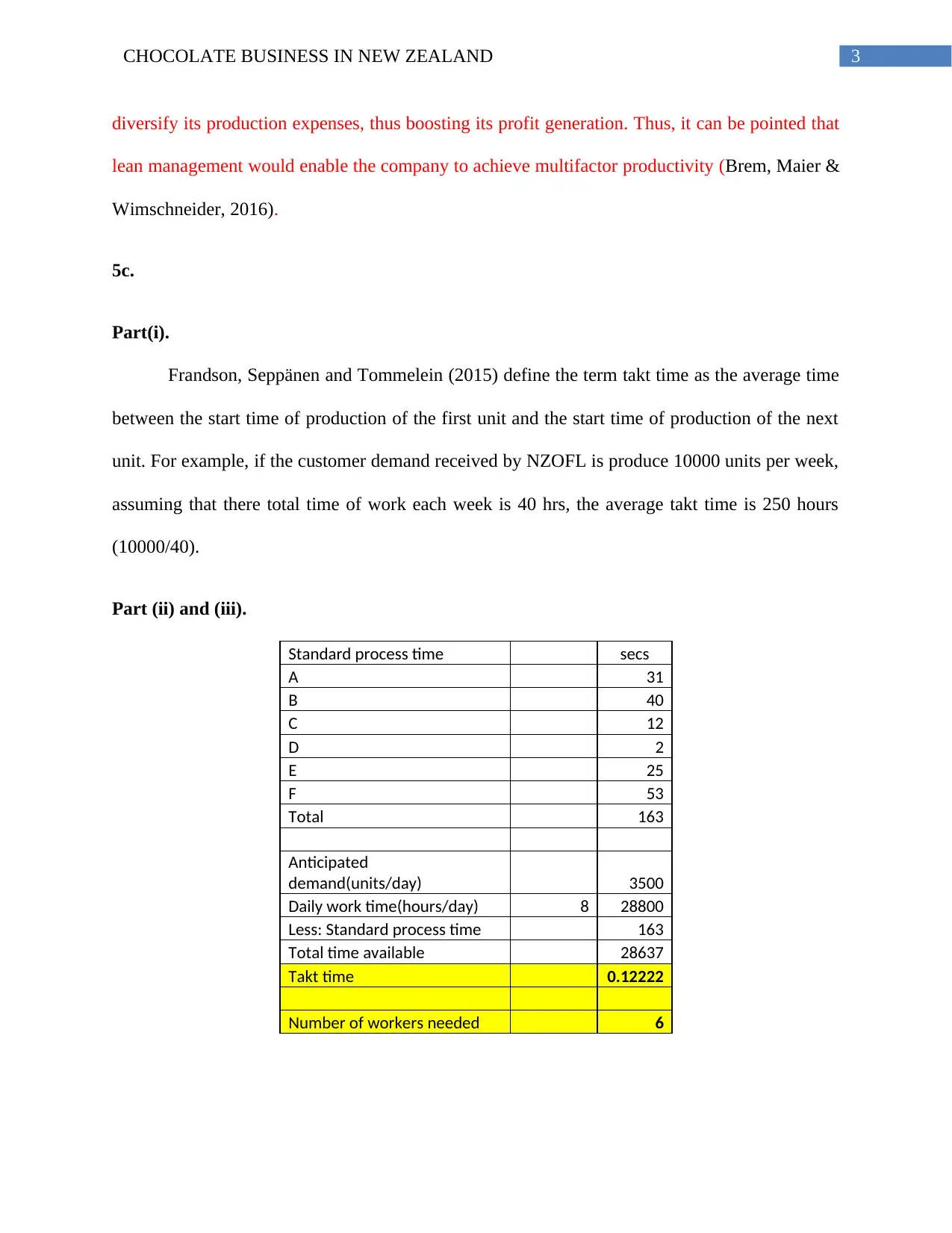
3CHOCOLATE BUSINESS IN NEW ZEALAND
diversify its production expenses, thus boosting its profit generation. Thus, it can be pointed that
lean management would enable the company to achieve multifactor productivity (Brem, Maier &
Wimschneider, 2016).
5c.
Part(i).
Frandson, Seppänen and Tommelein (2015) define the term takt time as the average time
between the start time of production of the first unit and the start time of production of the next
unit. For example, if the customer demand received by NZOFL is produce 10000 units per week,
assuming that there total time of work each week is 40 hrs, the average takt time is 250 hours
(10000/40).
Part (ii) and (iii).
Standard process time secs
A 31
B 40
C 12
D 2
E 25
F 53
Total 163
Anticipated
demand(units/day) 3500
Daily work time(hours/day) 8 28800
Less: Standard process time 163
Total time available 28637
Takt time 0.12222
Number of workers needed 6
diversify its production expenses, thus boosting its profit generation. Thus, it can be pointed that
lean management would enable the company to achieve multifactor productivity (Brem, Maier &
Wimschneider, 2016).
5c.
Part(i).
Frandson, Seppänen and Tommelein (2015) define the term takt time as the average time
between the start time of production of the first unit and the start time of production of the next
unit. For example, if the customer demand received by NZOFL is produce 10000 units per week,
assuming that there total time of work each week is 40 hrs, the average takt time is 250 hours
(10000/40).
Part (ii) and (iii).
Standard process time secs
A 31
B 40
C 12
D 2
E 25
F 53
Total 163
Anticipated
demand(units/day) 3500
Daily work time(hours/day) 8 28800
Less: Standard process time 163
Total time available 28637
Takt time 0.12222
Number of workers needed 6
Paraphrase This Document
Need a fresh take? Get an instant paraphrase of this document with our AI Paraphraser
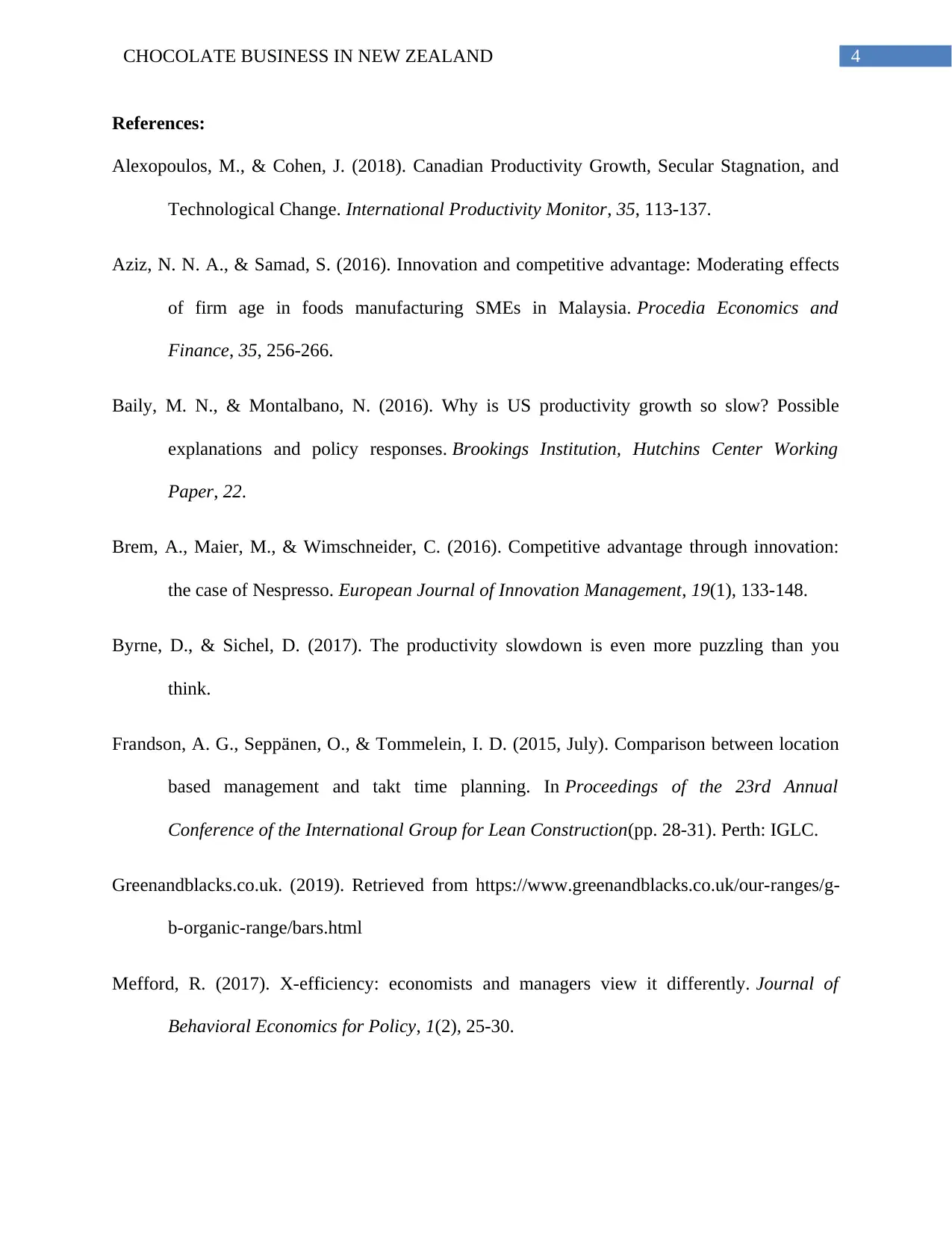
4CHOCOLATE BUSINESS IN NEW ZEALAND
References:
Alexopoulos, M., & Cohen, J. (2018). Canadian Productivity Growth, Secular Stagnation, and
Technological Change. International Productivity Monitor, 35, 113-137.
Aziz, N. N. A., & Samad, S. (2016). Innovation and competitive advantage: Moderating effects
of firm age in foods manufacturing SMEs in Malaysia. Procedia Economics and
Finance, 35, 256-266.
Baily, M. N., & Montalbano, N. (2016). Why is US productivity growth so slow? Possible
explanations and policy responses. Brookings Institution, Hutchins Center Working
Paper, 22.
Brem, A., Maier, M., & Wimschneider, C. (2016). Competitive advantage through innovation:
the case of Nespresso. European Journal of Innovation Management, 19(1), 133-148.
Byrne, D., & Sichel, D. (2017). The productivity slowdown is even more puzzling than you
think.
Frandson, A. G., Seppänen, O., & Tommelein, I. D. (2015, July). Comparison between location
based management and takt time planning. In Proceedings of the 23rd Annual
Conference of the International Group for Lean Construction(pp. 28-31). Perth: IGLC.
Greenandblacks.co.uk. (2019). Retrieved from https://www.greenandblacks.co.uk/our-ranges/g-
b-organic-range/bars.html
Mefford, R. (2017). X-efficiency: economists and managers view it differently. Journal of
Behavioral Economics for Policy, 1(2), 25-30.
References:
Alexopoulos, M., & Cohen, J. (2018). Canadian Productivity Growth, Secular Stagnation, and
Technological Change. International Productivity Monitor, 35, 113-137.
Aziz, N. N. A., & Samad, S. (2016). Innovation and competitive advantage: Moderating effects
of firm age in foods manufacturing SMEs in Malaysia. Procedia Economics and
Finance, 35, 256-266.
Baily, M. N., & Montalbano, N. (2016). Why is US productivity growth so slow? Possible
explanations and policy responses. Brookings Institution, Hutchins Center Working
Paper, 22.
Brem, A., Maier, M., & Wimschneider, C. (2016). Competitive advantage through innovation:
the case of Nespresso. European Journal of Innovation Management, 19(1), 133-148.
Byrne, D., & Sichel, D. (2017). The productivity slowdown is even more puzzling than you
think.
Frandson, A. G., Seppänen, O., & Tommelein, I. D. (2015, July). Comparison between location
based management and takt time planning. In Proceedings of the 23rd Annual
Conference of the International Group for Lean Construction(pp. 28-31). Perth: IGLC.
Greenandblacks.co.uk. (2019). Retrieved from https://www.greenandblacks.co.uk/our-ranges/g-
b-organic-range/bars.html
Mefford, R. (2017). X-efficiency: economists and managers view it differently. Journal of
Behavioral Economics for Policy, 1(2), 25-30.
1 out of 5
Related Documents
Your All-in-One AI-Powered Toolkit for Academic Success.
+13062052269
info@desklib.com
Available 24*7 on WhatsApp / Email
![[object Object]](/_next/static/media/star-bottom.7253800d.svg)
Unlock your academic potential
Copyright © 2020–2025 A2Z Services. All Rights Reserved. Developed and managed by ZUCOL.




